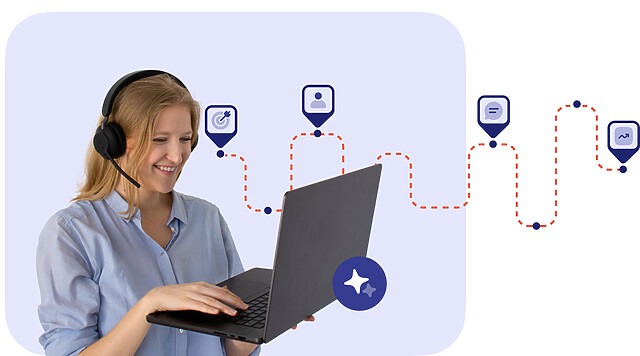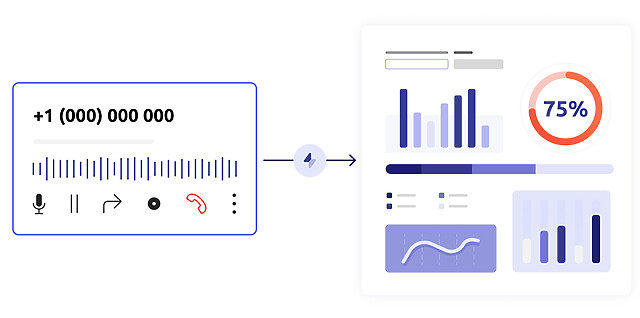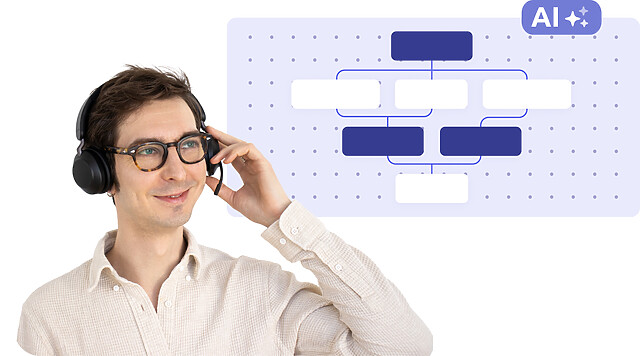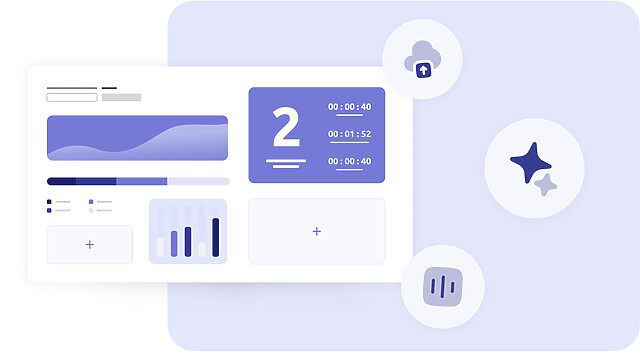Customer Journey Mapping with IVR
Leverage the power of intelligent automation to design smarter customer flows
What is Customer Journey Mapping?
Customer journey mapping is when a company maps, tests, and optimizes every step of the customer journey experience to eliminate friction across all paths. To improve CX interactions across all touchpoints, companies often deploy intelligent automation tools within their IVR flows, like context-aware routing, text-to-speech, and voice menus. These tools introduce smart features like automated pattern recognition, trigger-based journey optimization, and CRM integrations directly into your IVR flows. Within Diabolocom’s Scenario Builder, you can access a wide spectrum of keypresses and prompts to start mapping out your customer journeys using our intuitive drag-and-drop editor.

Benefits of Customer Journey Mapping for Call Centers
Enhanced Supervision and Control
Diabolocom’s versatile IVR platform makes it easy to adjust flows based on performance of live campaigns. The Analytics Dashboard gives supervisors end-to-end visibility of every step, pinpointing exactly where delays or misroutes occur.

Intelligent Automation
Integrate intelligent automation into IVR flows using elements like WebService, CheckAttribute, Counter, and CheckDate, creating efficient and brand-inspired experiences. Reduce call handling time and gather data directly from customers with error-free execution.

What are the Benefits of Intelligent Automation in IVR Flows?
Dynamic Call Routing Based on Time and Language
Capture the caller’s spoken language with SpeachRecognition and determine if the regional support team is open with CodeCheckTime. Send callers to the correct agent group or trigger a callback across timezones.
Real-Time Scoring & Post-Call Surveys
Diabolocom’s live-call scoring system eliminates the need for manual question-answer surveys. Now, you can seamlessly track agent performance and customer satisfaction in live calls, or just integrate real-time surveys into calls using survey tools to capture CSAT or NPS scores.
Drive Efficiency and Performance
Design Smarter Journeys. Optimize Every Step.
With Diabolocom’s IVR, design every touchpoint on the customer journey with precision. Use the drag-and-drop editor to tailor flows according to each caller group. Integrate intelligent tools like CRM syncing, contextual data, and speech recognition directly into your IVR flows.

FAQ
Why is customer journey mapping essential for contact centers?
By mapping out each stage of the journey map, contact centers gain a deeper understanding of customer behaviors, needs, and trends. It helps uncover friction points, gaps in communication, and opportunities for improvement. Most importantly, journey maps align your teams around the customer experience, ensuring marketing, sales, and support are working toward a unified goal.
How does customer journey mapping improve CX (customer experience)?
By identifying every step in the customer lifecycle, companies can proactively address pain points—such as long wait times, unclear messaging, or inconsistent support. It also helps tailor responses based on where a customer is in their journey, leading to more relevant and empathetic interactions.
What are the key stages in a typical customer journey map?
A standard customer journey map includes five to seven core stages, depending on your business model. These typically include:
Awareness – When the customer first becomes aware of a problem or your brand.
Consideration – They begin researching and evaluating potential solutions.
Decision – The customer decides to make a purchase or sign up.
Onboarding – Post-purchase or activation, the customer starts using your product or service.
Support – Ongoing engagement, including customer service and issue resolution.
Loyalty – The customer becomes a repeat buyer or advocate.
How can AI and analytics enhance customer journey mapping?
Traditional maps rely on assumptions, interviews, and surveys, which can quickly become outdated. With AI-powered platforms like Diabolocom, businesses can track real-time customer interactions—calls, chats, emails, and more—and identify behavioral patterns as they happen. For example, AI can detect when customers tend to abandon a process or when engagement dips after a certain touchpoint.